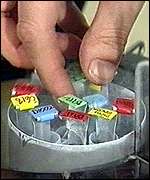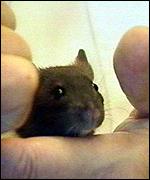
Human ovaries 'grown in mice'
URL: http://news.bbc.co.uk/hi/english/health/newsid_1190000/1190882.stm
Date accessed: 9 April 2001
Tuesday, 27 February, 2001, 00:14 GMT
And in what could be more good news for women threatened with infertility, a new technique appears to have greatly increased the number of frozen human eggs which can be subsequently fertilised.
Cryopreservation of ovarian tissues has real potential for clinical
application
|
|
Dr Debra Gook, Royal Women's Hospital
|
Women who undergo ovarian removal or chemotherapy for cancer often lose their fertility as a result, and can suffer early menopause.
While men whose fertility is threatened can elect to have semen frozen for later use, at the moment, the preservation - and reactivation - of eggs, and tissue from the ovary, is far more problematic.
Normal growth
A team of scientists from Melbourne, Australia, has now demonstrated that frozen human ovarian tissue, once thawed, can grow in a "normal" fashion.
The tissue was implanted into mice, and immature follicles within the tissue, which are supposed eventually to release the eggs for fertilisation, began to develop in a similar way to conventional ovarian tissue.

Ovary tissue and eggs can be frozen
|
"The high rate of functional preservation of follicles following cryopreservation also suggests that cryopreservation of ovarian tissues has real potential for clinical application."
Another piece of Australian research also found that mouse ovarian follicles could be frozen and thawed, then similarly developed under laboratory conditions.
Egg success
Pioneering doctors had implanted previously frozen ovarian tissue into an American woman, Margaret Lloyd-Hart, but the procedure was not a success. The follicles within the ovarian tissue did not develop fully.
Dr Simon Fishel, of the Care IVF clinic in Nottingham, UK, described the ovarian advance as "very exciting", although he stressed it was unlikely to be a reliable treatment inside five years.
He said: "It's an extension of what has been done before. This is certainly going to happen - it's just a question of when and how."
Only 30 babies have been born worldwide using frozen eggs - the success rate is extremely low.
However, a team from the University of Bologna, Italy, say they have found a way of improving the egg's chances of surviving the freezing process.
Sucrose concentration
Water left in the egg causes damage to its fragile contents during freezing. Sucrose in the freezing solution is used to draw water out through the cell membrane.
The Bologna team doubled or even tripled the concentration of sucrose, and found great improvements in the proportion of eggs which survived the freezing process.

The ovarian tissue developed normally inside the mouse
|
Furthermore, 57% could be fertilised using fertility techniques, and 90% of those fertilised showed all the characteristics of "healthy" embryos.
Dr Rafaella Fabbri, who led the research, said: "It is very important that we improve the possibilities for women to become pregnant after having their eggs frozen."
Dr Fishel commented that while frozen egg fertility treatments seemed to have the greatest current potential in the short term, there were still safety concerns about possible genetic damage within the egg during the dehydrating and freezing process.
Category: 1. Advances in Science